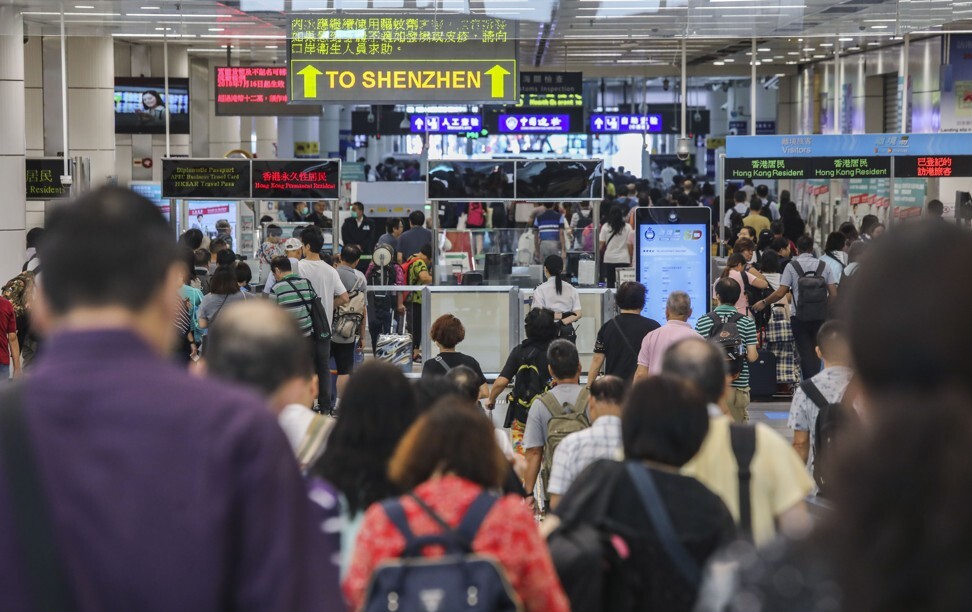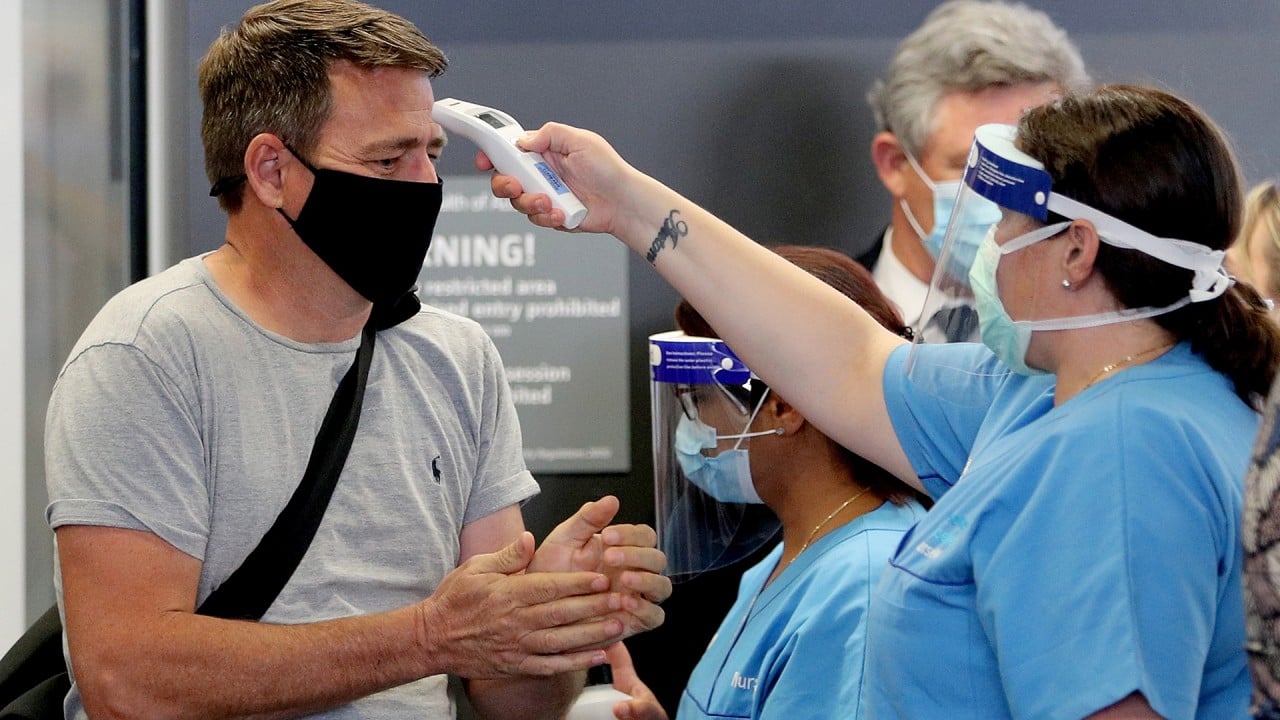
Explainer | ‘Zero infections’ for Hong Kong a tough Covid-19 goal, but city keeps going with eye on easing mainland China border restrictions
- Current streak of 41 days without local infections a record, with three cases recently reclassified
- City keeps pandemic mostly under control, but needs to persuade Beijing to ease restrictions
Hong Kong has been aggressively pursuing the goal of zero Covid-19 infections as it seeks to ease travel restrictions with mainland China. The city closed all but three border checkpoints in February last year as part of pandemic measures.
Chief Executive Carrie Lam Cheng Yuet-ngor said on Monday that she had submitted a report to Beijing on the city’s Covid-19 situation in the hope of reopening the border.
Carrie Lam wants quarantine-free business travel, but ‘final decision with Beijing’
The mainland is Hong Kong’s largest trading partner, so restoring cross-border travel is considered a priority by city leaders looking to revive the economy.
Although the pandemic is largely under control in Hong Kong, insiders say the final decision on reopening the border rests with Beijing.
The Post unpacks what you need to know about Hong Kong’s epidemic situation and what it means for discussions on reopening the border with the mainland.
What does “zero infections” mean?
Unlike Israel and Singapore, which have described moving towards a new normal of “living with Covid-19”, Hong Kong has stuck to its zero-infections goal.
Hong Kong on course for 70 per cent milestone in Covid-19 jabs push for first doses
Chinese University’s Professor David Hui Shu-cheong, who advises the government on its pandemic response, said Hong Kong would achieve its goal of zero infections if it went 28 consecutive days without a local infection.
So far, the longest Hong Kong has gone without local infections is the current streak of 41 days, although that includes cases have been reclassified.
Hui said the clean record was affected each time a local case emerged, even if it was later reclassified when the patient was found to be linked to an imported case.
“They are two different things. The reclassification has to do with the source of infection, which health authorities must make clear under the existing mechanism,” he said.
“But the change has no impact on whether there has been community spread of Covid-19. We still need to observe for 28 days because the patient has been out and about.”
How has Hong Kong done so far?
Hong Kong recorded two new imported Covid-19 infections on Sunday, taking the city’s official tally to 11,958 cases, with 212 related deaths.
Healthy Hong Kong residents unlikely to need third Covid-19 jab: adviser
Health authorities generally classify infections detected in the city as: local, referring to those without a traceable source; epidemiologically linked with local cases; imported, or epidemiologically linked with imported cases.
The last time Hong Kong recorded a community case was on June 7, when a 20-year-old woman, whose younger sister contracted the Alpha variant locally, was confirmed as infected.
There have been no other local Covid-19 cases since then, making it 41 days and counting.
But there have been three patients who appeared initially to be local cases but were subsequently reclassified as linked to imported cases following genome sequencing tests.

Untraceable: How did the teenager get infected?
Hong Kong has gone 43 days without an untraceable local infection.
On June 5, a 17-year-old schoolgirl with no travel history broke the city’s 42-day streak of zero untraceable cases.
Allowing vaccinated arrivals into Hong Kong ‘dangerous’; city logs 1 new imported Covid-19 case
After she tested positive for the more virulent Alpha variant, first found in Britain, her mother and sister also tested positive.
Dr Gilman Siu Kit-hang, an associate professor from Polytechnic University, who was involved in genetic analysis of local Covid-19 cases, compared genome sequencing of the virus from the girl with that from earlier imported cases.

Her sample was also compared with the sequences of about 70,000 global cases with the same Alpha variant recorded between April and May, but no matches were found.
How the girl was infected remains a mystery.
Which cases were reclassified recently?
Three cases initially classified as local infections were reclassified as linked to imported cases following genome sequencing tests.
On June 24, a 27-year-old airport worker was confirmed to be infected with the Delta coronavirus variant first detected in India.
His case was reclassified after tests showed his infection to be identical to that of three imported cases from Indonesia. He had encountered those three people briefly at the airport’s sample collection centre on June 11.

05:33
Covid-19 Delta variant: how infectious it is and how it may ‘shift thinking’ on countries reopening
On July 2, a 41-year-old part time cleaner at a designated quarantine hotel was confirmed to be infected with the Delta variant. Her case was reclassified after genetic sequencing linked her to a domestic worker from Indonesia.
The Indonesian woman had spent her quarantine at the hotel, and the 41-year-old cleaned her room.
BioNTech vaccine creates 10 times more antibodies than Sinovac, study finds
In the third case, a 50-year-old airport porter was confirmed infected on July 11. His case was reclassified as linked to imported cases after genome sequencing connected him to four imported cases from Russia.
Those cases involved a crew member of a cargo flight which arrived from Moscow on July 6. The porter worked on the aircraft for several hours that day and although he did not have direct contact with the crew member, some turnaround crew remained on board throughout, the health department said.
Is there a loophole in Hong Kong’s infection control measures?
Of the three reclassified cases, the airport worker and part-time hotel cleaner were not vaccinated against Covid-19, and the porter had received only one shot.
“They come into contact with many people who have been overseas, so they are partly responsible,” said Professor David Hui. “This is a loophole and high-risk groups should be encouraged to get vaccinated.”
Talks on cross-border travel with Guangdong must start over: Hong Kong leader
He stopped short of calling for mandatory vaccination for high-risk groups, noting that Hong Kong’s vaccination programme is voluntary.
“People could argue that it is unfair that certain groups are being targeted, so those who choose not to get vaccinated should be required to undergo regular testing and pay for it themselves,” he said.
So far 37.6 per cent of Hong Kong’s 7.5 million people have received one dose of the vaccine, and 26.8 per cent have received both doses.
Should jabs be compulsory for some?
Respiratory medicine expert Dr Leung Chi-chiu urged the government to consider mandating vaccination for high-risk groups or have them transferred to other jobs.
“The government must show there is a need to protect not only the workers themselves at their place of employment, but also the community as a whole,” he said.
Officials could decide whether a whole sector should be required to get their jabs or only those more at risk of contracting the virus, such as frontline health care workers.
He said it would be futile for Hong Kong to keep asking the mainland to ease border restrictions if it did not improve its infection control measures.
“How can others have confidence in Hong Kong if we keep allowing imported cases to get past our defences? Leaders will have to take responsibility if a new outbreak occurs.”

